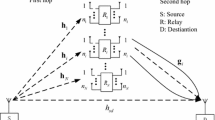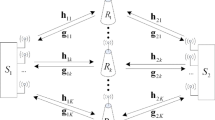Abstract
Relaying communications has been proposed as a way to provide spatial diversity. In general, one is interested in a relaying system that can achieve the maximal diversity order with a low system complexity. One enabling technique is equal gain combining (EGC) and its application in relaying systems is the main focus of this paper. In particular, the techniques of EGC and smart relaying are combined in the decode-and-forward (DF) processing method. It is shown that for a system with one relay and M-ary phase-shift-keying (M-PSK) modulation, maximal diversity orders of 2m and 2 are achieved over Nakagami-m and Hoyt fading environments, respectively. With K relays, simulation results suggest that the corresponding diversity orders are m(K + 1) and (K + 1).
Similar content being viewed by others
References
Sendonaris A., Erkip E., Aazhang B. (2003) User cooperation diversity—part 1: System description. IEEE Transactions on Communications 51: 1927–1938
Sendonaris A., Erkip E., Aazhang B. (2003) User cooperation diversity—part 2: Implementation aspects and performance analysis. IEEE Transactions on Communications 51: 1939–1948
Laneman J. N., Tse D. N. C., Wornell G. W. (2004) Cooperative diversity in the wireles networks: Efficient protocols and outage behavior. IEEE Transactions on Information Theory 49: 3062–3080
Michalopoulos D., Karagiannidis G. (2008) Phy-layer fairness in amplify and forward cooperative diversity systems. IEEE Transactions on Wireless Communication 7(3): 1073–1082
Bhargava, V. K. (2008). Special issue on cooperative communications. IEEE Transactions on Wireless Communication, 7(5).
Wang T., Cano A., Giannakis G. B., Laneman J. N. (2007) High–performance cooperative demodulation with decode–and–forward relays. IEEE Transactions on Communication 55: 1427–1438
Wang, T., Wang, R., & Giannakis, G. B. (2006). Smart regenerative relays for link–adaptive cooperative communications. In Proceedings of 40th Annual Conference on Information Sciences and Systems, pp. 1038–1043, Mar. 2006.
Wang T., Giannakis G., Wang R. (2008) Smart regenerative relays for link-adaptive cooperative communications. IEEE Transactions on Communication 56: 1950–1960
Vien N. H., Nguyen H. H., Le-Ngoc T. (2009) Diversity analysis of smart relaying. IEEE Transactions on Vehicle Technology 58: 2849–2862
Yi Z., Kim I.-M. (2008) Diversity order analysis of the decode-and-forward cooperative networks with relay selection. IEEE Transactions on Wireless Communication 7: 1792–1799
Ribeiro A., Cai X., Giannakis G. (2005) Symbol error probabilities for general cooperative links. IEEE Transactions on Wireless Communication 4: 1264–1273
Bletsas A., Khisti A., Reed D., Lippman A. (2006) A simple cooperative diversity method based on network path selection. IEEE Journal of Selected Areas in Communication 24: 659–672
Shin H., Song J. (2008) MRC analysis of cooperative diversity with fixed-gain relays in Nakagami-m fading channels. IEEE Transactions on Wireless Communication 7: 2069–2074
Simon M. K., Alouini M.-S. (2004) Digital communication over fading channels. (2nd ed.). Wiley-IEEE Press, NJ
Karagiannidis G. K. (2006) Performance bounds of multihop wireless communications with blind relays over generalized fading channels. IEEE Transactions on Wireless Communication 5: 498–503
Radaydeh R., Matalgah M. (2008) Non-coherent improved-gain diversity reception of binary orthogonal signals in Nakagami-q (Hoyt) mobile channels. Communications, IET 2(2): 372–379
Iskander C. D., Mathiopoulos P. T. (2008) Exact performance analysis of dual-branch coherent equal–gain combining in Nakagami–m, Rician, and Hoyt fading. IEEE Transactions on Vehicular Technology 57: 921–931
Simon M. K., Alouini M.-S. (2005) Digital communication over fading channels (2nd ed.). Wiley-IEEE Press, NJ
Adeane, J., Rodrigues, M. R. D., & Wassell, I. J. (2005). Characterisation of the performance of cooperative networks in Ricean fading channels. (2nd ed.). In Proceedings of the International Conference on Telecommunications. Cape Town, South Africa, May 2005.
Proakis J. G. (2001) Digital communications. (4th ed.). McGraw-Hill, NY
Gradshteyn L. S., Ryzhik L. M. (2007) Tables of integrals, series and products. (7th ed.). Academic Press, NY
Abramowitz M., Stegun I. A. (1972) Handbook of mathematical functions with formulas, graphs, and mathematical tables. Department of Commerce, U.S.
Joshi C. M., Bissu S. K. (1991) Some inequalities of Bessel and modified Bessel functions. Journal of the Australian Mathematical Society 50(2): 333–342
Author information
Authors and Affiliations
Corresponding author
Rights and permissions
About this article
Cite this article
Vien, N.H., Nguyen, H.H. & Le-Ngoc, T. Performance Analysis of Smart Relaying with Equal Gain Combining. Wireless Pers Commun 65, 273–292 (2012). https://doi.org/10.1007/s11277-011-0249-z
Published:
Issue Date:
DOI: https://doi.org/10.1007/s11277-011-0249-z




